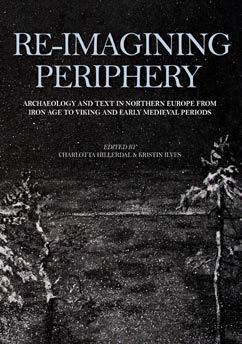
3 minute read
ROME & THE ROMAN PROVINCES
Archaeology and Text in Northern Europe from Iron Age to Viking and Early Medieval Periods Edited by Charlotta Hillerdal and Kristin Ilves A collective summary of our current understandings of Iron Age and early medieval northern Europe.
Delves into the current state of Iron Age and early medieval research in northern europe. Over the last two decades of archaeological explorations, theoretical vanguards and new methodological strategies, together with a growing amount of multidisciplinary critical studies in archaeology, have dramatically changed our understanding of northern Iron Age societies. This book provides a collective summary of our understanding and facilitates a renewed interaction between academia and the ever-growing field of infrastructural archaeology.
Advertisement
Oxbow Books • 9781789254501 • Hardback • b/w illus. 280 x 216mm • 200 pages • June 2020 • £45.00
EBOOK AVAILABLE
Everyday Life in Viking-Age Towns
Social Approaches to Towns in England and Ireland, c. 800–1100 Edited by Letty ten Harkel and D.M. Hadley Explores everyday life in Viking-Age towns from both sides of the Irish Sea.
The study of early medieval towns has frequently concentrated on urban beginnings, the search for broadly applicable definitions of urban characteristics and the chronological development of towns. This book focuses instead on everyday life in and around these emerging settlements. What was it really like to grow up, live and die in these towns? What did people eat, what did they wear and how did they make a living for themselves?
Oxbow Books • 9781789255461 • New in Paperback 242 x 170mm • 272 pages • July 2020 • £29.95
EBOOK AVAILABLE
Exploring Celtic Origins
New Ways Forward in Archaeology, Linguistics, and Genetics Edited by Barry Cunliffe and John T. Koch Explores the background of Celts and speakers of Celtic languages.

The fruit of collaborative work by researchers in archaeology, historical linguistics and archaeogenetics over the past ten years, this book aims to improve understanding of the background in the Bronze Age and Beaker Period of the people who emerge as Celts and speakers of Celtic languages documented in the Iron Age and later times. Contributors present multidisciplinary chapters in a lively user-friendly style, aimed at accessibility for workers in the other fields, as well as general readers.
Britain and Ireland, AD 800–1600 By Neil Christie and Paul Stamper
This book offers a comprehensive analysis of early to late medieval settlement, land use, economics and population, bringing together evidence drawn from archaeological excavations and surveys, historical geographical analysis and documentary and place-name study. Extensively illustrated in colour and black and white, and written by expert contributors, the volume includes a comprehensive, integrated bibliography and an index. It will be essential reading for everyone researching and interested in medieval settlements and the medieval rural landscape.
Windgather Press • 9781911188674 • New in Paperback 246 x 185mm • 304 pages • October 2020 • £25.00
EBOOK AVAILABLE
Horse and Rider in the Late Viking Age
Edited by Merete Schifter Bagge and Anne Pedersen Places a rich equestrian burial from the 10th century in a wider context.
In 2017 an exceptionally rich equestrian burial from the 10th century was discovered at Fregerslev near Skanderborg, Denmark, which contained a high-status horseman, buried with valuable grave goods. This volume seeks to place the burial in a wider context and to determine whether the burial was an expression of a new powerful elite, of new religious symbolism, funerary rituals, or new cultural impulses and changing values.
Aarhus University Press • 9788771849981 • Hardback 297 x 210mm • 280 pages • October 2020 • £35.00
Pecsaetna
People of the Anglo-Saxon Peak District By Phil Sidebottom Recent research into the ‘lost’ Anglo-Saxon Pecsaetna people.

This book is intended to pull together our current knowledge of the ‘lost’ group of people called the Pecsaetna (literally, meaning the ‘Peak Sitters’) by synthesising more recent historical and archaeological research towards a better understanding of their activities, territory and identity. This group of people is shrouded in the mists of the so-called ‘Dark Ages’ and are only known to us by the chance survival of less than a handful of documents.







